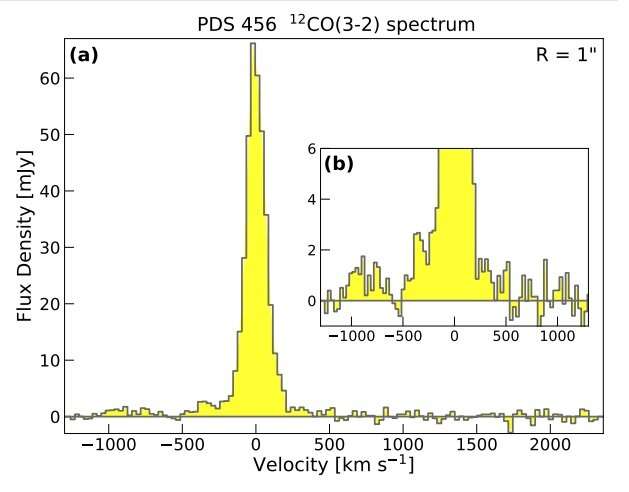Giant molecular outflow detected from the quasar PDS 456

Using the Atacama Large Millimeter/submillimeter Array (ALMA) in Chile, astronomers have detected a galaxy-wide molecular outflow from the quasar PDS 456. The findings are presented in a paper published March 25 on arXiv.org, in which the authors investigate the properties of this outflow.
Powered by supermassive black holes (SMBHs), quasars, or quasi-stellar objects (QSOs) are extremely luminous active galactic nuclei (AGN) with luminosities even thousands of times greater than that of our Milky Way galaxy. Most quasars are known to eject huge amounts of material into their host galaxies. Hence, detecting and observing such outflows could provide important hints about the evolution of galaxies.
At a redshift of 0.18 and with bolometric luminosity of about 100 quattuordecillion erg/s, PDS 456 is the most luminous radio-quiet quasar in the local universe. The widespread presence of outflows in this quasar, together with its relative proximity and high luminosity, make it an ideal candidate to study molecular outflows and the effects of the quasar activity on the host-galaxy interstellar medium.
A group of astronomers led by Manuela Bischetti of the Observatory of Rome, Italy, has conducted ALMA observations of the 1 mm continuum and CO(3−2) line emission in PDS 456. This observations resulted in the detection of several blue-shifted clumps reaching out to about 16,000 light years from the nucleus, which revealed the presence of a large galaxy-wide molecular outflow in this quasar.
“The CO(3−2) emission line profile shows a blue-shifted tail (whose flux density is about 1/60 of the line peak), extending to v ~−1000 km/s, and a red-shifted wing at v < 600 km/s associated with molecular outflowing gas. The outflow is characterized by a complex morphology, as several clumps with blue-shifted velocity are detected over a wide region out to ~5 kpc from the nucleus,” the astronomers wrote in the paper.
The observations revealed that this outflow has a total mass of around 250 million solar masses and a mass outflow rate of about 290 solar masses per year. These values indicate that it is a remarkably weak outflow for such a luminous quasar like PDS 456, in which one of the fastest and most energetic ultra-fast outflows (UFOs) had been detected.
Furthermore, the researchers calculated that the depletion timescale for the molecular gas in PDS 456 is at a level of approximately 8 million years, what is about four to 10 times shorter than the rate at which the molecular gas is converted into stars. This, according to the study, points to a possible quenching of the star-formation activity in the host galaxy within a short time.
The research also underlined that the time necessary for the UFO to supply the energy measured for the molecular outflow in PDS 456 is about two times shorter than that for active galactic nuclei at lower bolometric luminosities. This may suggest that the UFO in the studied quasar was observed in its outburst phase, or that the molecular phase is not representative of the total outflow energy in hyper-luminous sources. All in all, more studies of PDS 456 should be carried out in order to verify these hypothesis.



 Creators of mankind
Creators of mankind Description of “Tall white aliens”
Description of “Tall white aliens” Where they came from?
Where they came from? About hostile civilizations
About hostile civilizations The war for the Earth
The war for the Earth “Tall white aliens” about eternal life
“Tall white aliens” about eternal life Video: “Nordic aliens”
Video: “Nordic aliens” Aliens
Aliens Alien encounters
Alien encounters The aliens base
The aliens base UFO
UFO Technology UFO
Technology UFO Underground civilization
Underground civilization Ancient alien artifacts
Ancient alien artifacts Military and UFO
Military and UFO Mysteries and hypotheses
Mysteries and hypotheses Scientific facts
Scientific facts


















